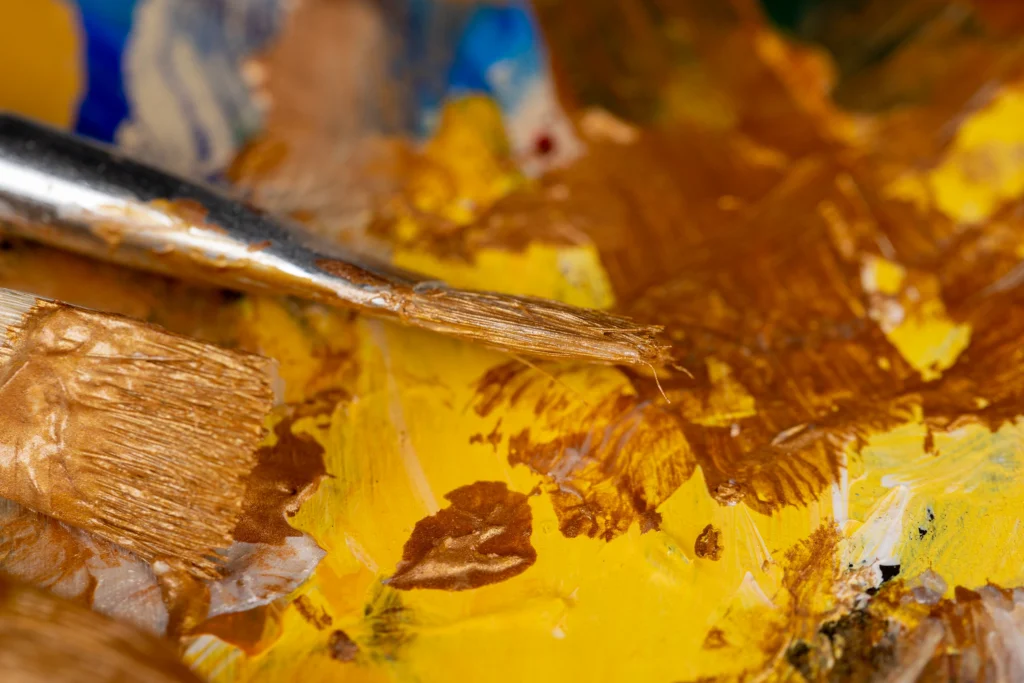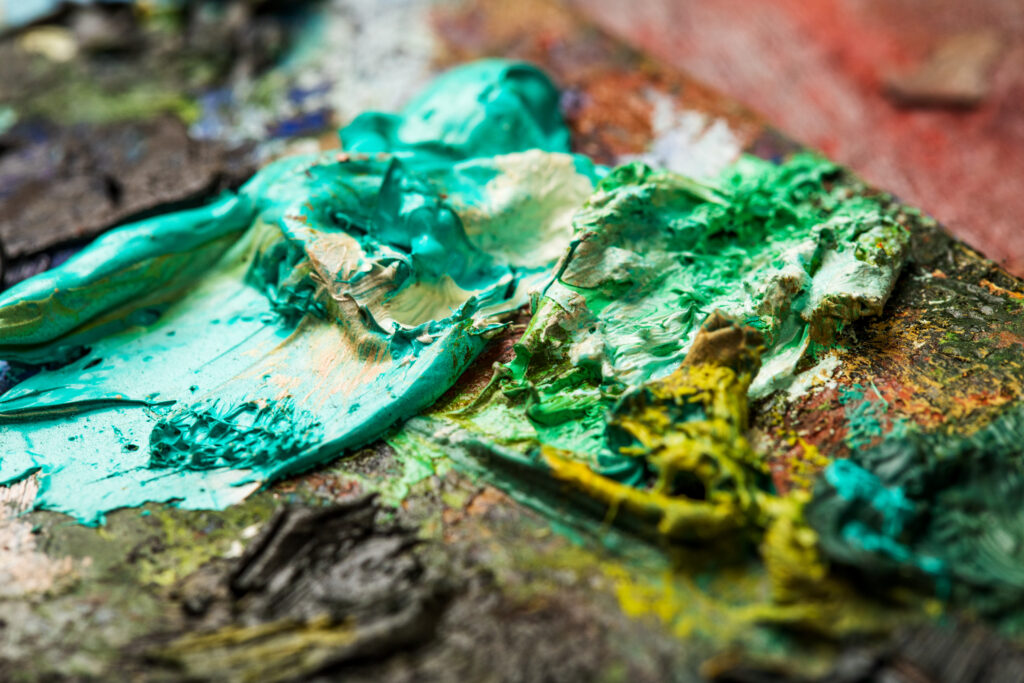When it comes to oil painting, the paint is undoubtedly the main component. However, there are other essential products that play an equally important role in the artistic process: mediums. Mediums are substances added to paint to alter its consistency, drying time, and finish. Understanding how to use them correctly is crucial for achieving the best results in your work and avoiding future problems like cracking or discoloration.
In this article, we will explore the role of mediums in oil painting, discussing different products such as solvents, drying oils, resins, and varnishes, and providing tips on when and how to use them safely and effectively. We will also touch on ecological and practical alternatives for environmentally conscious artists.
What Are Mediums in Oil Painting?
Mediums are substances that can be mixed with oil paint to modify its texture, viscosity, shine, and drying time. While oil paint itself is quite versatile, mediums allow the artist to have more precise control over the final outcome of the work, whether it’s achieving specific effects like glazing or adjusting the drying speed. They are used to dilute the paint, change how it applies to the canvas, improve drying, or even alter the final finish of the painting. With the right combination of mediums, the artist can create a multitude of effects and textures to enhance their artwork.
Understanding the function and proper use of mediums is essential for those who wish to refine their technique and achieve professional results. Let’s explore the main types of mediums used in oil painting.

Solvents in Oil Painting
Mineral Spirits
Mineral spirits are one of the most common solvents used in oil painting. They are used to dilute the paint, making it more fluid and allowing the artist to apply the paint more easily. Additionally, mineral spirits are widely used for cleaning brushes and other materials.
However, the use of mineral spirits requires caution. If used excessively, it can affect the intensity of the colors and compromise the quality of the paint, making it more transparent and less opaque. Another important point is the need for proper ventilation, as mineral spirits release strong fumes that can be harmful to health.
Turpentine
Turpentine is a natural solvent derived from pine resin. It has a faster evaporation rate compared to mineral spirits, which can speed up the drying time of the painting. Turpentine is often used when the artist wants a more delicate painting with faster drying.
It can also be used to clean brushes, but like mineral spirits, it should be handled carefully due to its toxic fumes. Turpentine has a strong smell and should be used in well-ventilated areas.
Drying Oils: Linseed and Poppy
Linseed Oil
Linseed oil is the most common and widely used drying oil in oil painting. It accelerates the drying time of the paint and provides a creamier, richer consistency. When added to paint, linseed oil helps form a solid film, allowing subsequent layers to be applied more easily.
Although effective in accelerating drying, excessive use of linseed oil can make the painting too shiny and susceptible to cracking over time. Therefore, it’s important to use it in moderation and balance it with other mediums.
Poppy Oil
Poppy oil is an alternative to linseed oil. While it has a slower drying time compared to linseed oil, poppy oil does not yellow over time, making it ideal for works that require a lighter or more delicate tone.
This oil is great for delicate work or for techniques requiring more drying time, such as glazing (thin layers of paint). While poppy oil provides a slower drying time, it doesn’t offer the same level of viscosity as linseed oil, being more fluid and suitable for detailed paintings.
Resins and Varnishes
Resins
Resins are natural or synthetic substances that can be mixed with paint or used as a medium to modify the shine and durability of the painting. They help increase adhesion between paint layers and the resistance of the artwork, creating a harder surface that is less susceptible to damage.
Resins can provide glossy and vibrant finishes. However, they should be used with care, as excessive use can make the painting rigid and less flexible. They can also alter the paint’s color, so it’s important to test them before applying directly to the artwork.
Varnishes
Varnishes are applied after the painting is fully dry to protect the work and provide the desired finish, whether glossy, matte, or satin. Varnish acts as a protective layer that helps preserve the color and durability of the painting.
There are various types of varnishes, such as Dammar varnish, which provides a glossy finish, or matte varnish, which gives a more subdued look. Varnish should only be applied once the painting is completely dry to avoid interfering with the paint layers.

When to Use Each One: Tips and Caution
Ideal Combinations
The combination of mediums can be made according to the needs of each painting. For example, if the artist desires a more fluid effect with quicker drying, mineral spirits can be combined with linseed oil. If the intention is to work with thicker and slower layers, poppy oil might be a better choice.
It is also important to conduct tests to see how the mediums affect the behavior of the paint, particularly in relation to drying and final shine.
Risks of Improper Use
While mediums are useful tools, improper use can cause serious problems. Excessive use of solvents can result in paints with low opacity and unwanted effects, such as uneven drying. Similarly, excessive use of drying oils can lead to cracking due to uneven drying of the layers.
It’s also important to be aware of the health risks, such as inhaling toxic fumes from mineral spirits and turpentine. Always use these products in well-ventilated areas and with proper precautions.
The “Fat Over Lean” Rule
The “fat over lean” rule is one of the most important principles when painting with oil. It states that thicker layers of paint (those with more oil or medium) should be applied over thinner layers (those with less oil or medium). This ensures that the top layer dries properly without causing structural problems in the painting.
By following the “fat over lean” rule, the artist ensures the painting dries evenly and without the risk of cracking or distortions in the layers. Start with a leaner paint (using solvents like turpentine) and add more medium or oil to subsequent layers.
Master Mediums and Transform Your Oil Paintings
Understanding the role of mediums in oil painting and knowing how to use them correctly is essential for high-quality artistic work. Mediums like solvents, drying oils, resins, and varnishes offer a variety of possibilities that can transform your paintings, providing unique effects, better control over drying, and stunning finishes.
By following the tips and respecting the “fat over lean” rule, you will be better prepared to create works with greater durability and beauty. The key is to experiment and find the ideal combination of mediums for each technique and style of painting, always keeping in mind the risks of improper use.
With the right knowledge, you’ll be able to explore the full potential of oil painting and achieve amazing results in your works!

